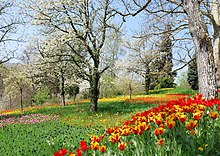What a Woman Dreams in Spring (1959)
| Movie | |
|---|---|
| Original title | What a woman dreams in spring |
| Country of production | Germany |
| original language | German |
| Publishing year | 1959 |
| length | 99 minutes |
| Age rating | FSK 12 |
| Rod | |
| Director | Erik Ode |
| script |
Curth Flatow Eckart Hachfeld |
| production | Artur Brauner |
| music |
Walter Kollo Willi Kollo |
| camera | Karl Löb |
| cut | Kurt Zeunert |
| occupation | |
| |
What a woman dreams in spring is a German love story by Erik Ode from 1959.
action
Elisabeth Brandt has been married to the toy manufacturer Johannes for 20 years, to whom work has always been more important than his family. Even the honeymoon had to be postponed because of appointments and in the end never took place. Now Johannes misses the return of his daughter Helga, who lived in Switzerland for two years, because of business negotiations with the Japanese . Helga wanted to become a painter, but made a new decision in the distance. The young woman, who is considered spoiled and spoiled, now wants to become a writer and uses the stage name “Therese Fanal”.
It is Helga's birthday and Johannes is therefore planning a big party in his house, to which he also invites his colleague Fritz Bergstedt. Johannes' secretaries warned him about Helga and wanted to buy her a painter's portfolio for her birthday. In the shop he meets Helga, whom he has never seen before, and is interested in her. When he hears her raving about writers, he poses as the author "Victor Molinar" while she introduces herself to him as "Therese Fanal". Neither of them appear at the birthday party, as Fritz pretends to have to leave for Paris . However, he apparently only stays in town for "Therese". Helga is happy, but shortly afterwards learns that the real Victor Molinar has passed away for many years. Fritz confesses to her that he is only an employee of the Brandt company, and Helga already wants to confess that she is his boss's daughter, but he complains about the "spoiled daughter" of his superior, so that she leaves him, but suggests, To know Johannes well and to thank him a lot. Johannes, in turn, promises his dissatisfied wife to go with her on a honeymoon to Konstanz for two weeks , but then asks her to drive up without him because he has to go to Zurich on business . Elisabeth travels to Constance alone, while Johannes flies to Zurich with Helga.
During her trip, Elisabeth makes a detour to Mainau , where she happens to meet her childhood sweetheart, the violinist Pierre Bonvant, again. Although he is in a relationship with singer Madeleine, he suffers from her justified jealousy. So he spends the evening with Elisabeth, who enjoys having a man stop work for her. Johannes, on the other hand, postpones his arrival in Constance until the next day, because the business partners will not arrive in Zurich until the next day. Elisabeth learns this and now wants to stay on Mainau Island overnight. However, being with Pierre is different than planned: Although he wants to get closer to her in a boat on Lake Constance , she remains loyal to Johannes. Both come ashore the next morning because the motorboat doesn't want to start anymore. At that point, Johannes has already arrived in Constance because the jealous Fritz has suddenly arrived in Zurich to save "Therese" from Johannes - the fraud can be cleared up and Fritz takes over the negotiations in Zurich. In the end, Johannes jealously awaits his wife, who in turn, through some misunderstandings, soon believes that Johannes is having an affair with Madeleine. In the end, the two couples get along again and Fritz and Helga, whose relationship takes a few turns, become a couple. Johannes also realizes that his factory can run without him: his little son Rudi was able to sell his own invention to the Japanese and, with the help of his grandmother, is also involved in marketing it worldwide on his own.
production
What a woman dreams of in spring was initially filmed from May to June 1958 on the island of Mainau , in Konstanz, on Lake Constance as well as in the CCC studios in Berlin-Spandau and at the Bahnhof Zoo in Berlin. Since Rudolf Prack fell ill, the shoot had to be interrupted. Further shooting took place in November 1958 in Vienna and Berlin. Production management was in the hands of Horst Wendlandt ; the costumes created Maria Brown , the Filmbauten come from Emil Hasler and Walter Kutz . Christine Görner sings, accompanied by the Rias dance orchestra, the song Once you will be loyal to me again . Richard Allan and Rosemarie Renz are dancing .
The film had its premiere on February 19, 1959 in the Ufa-Palast in Kassel .
criticism
“Emotionally exaggerated cinema history devoid of any interest in realities,” said the film service . For Cinema , the film was “a colorful nothing with 50s stars”.
Web links
- What a woman dreams in spring in the Internet Movie Database (English)
- What a woman dreams of in spring at filmportal.de
Individual evidence
- ↑ See disposition plan for re-shooting of the film
- ↑ What a woman dreams in spring. In: Lexicon of International Films . Film service , accessed March 2, 2017 .
- ↑ See cinema.de
